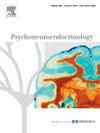Perceived discrimination and monocyte abundance in older adults: Findings from the Health and Retirement Study
IF 3.4
2区 医学
Q2 ENDOCRINOLOGY & METABOLISM
引用次数: 0
Abstract
Perceived discrimination is a pervasive social stressor linked to adverse health outcomes, and these effects appear to be mediated at least in part by immune system alterations that may affect inflammation-related diseases. To determine the cellular mechanisms involved, we investigated the association between everyday perceived discrimination and circulating monocyte counts in data from the 2016 Health and Retirement Study Venous Blood Study (n = 6332). After adjusting for age, sex, race/ethnicity, body mass index, smoking, and alcohol consumption, individuals reporting higher levels of perceived discrimination exhibited increased total monocyte counts, with a 9 % relative increase in total monocyte counts per 4-standard deviation increase in perceived discrimination scores (95 % CI: 0.01, 0.17). These effects stemmed primarily from increased abundance of classical monocytes, with no significant associations for non-classical monocytes. These results suggest that perceived discrimination may contribute to disease at least in part via increased monocyte abundance. These findings underscore the importance of addressing perceived discrimination as a social determinant of health and highlight the need for further research on the immunological pathways involved.
老年人的感知歧视和单核细胞丰度:来自健康和退休研究的发现
感知歧视是一种普遍存在的与不良健康结果相关的社会压力源,这些影响似乎至少部分是由免疫系统改变介导的,免疫系统改变可能影响炎症相关疾病。为了确定所涉及的细胞机制,我们在2016年健康与退休研究静脉血研究(n = 6332)的数据中研究了日常感知歧视与循环单核细胞计数之间的关系。在调整了年龄、性别、种族/民族、体重指数、吸烟和饮酒等因素后,报告感知歧视水平较高的个体表现出总单核细胞计数增加,感知歧视评分每增加4个标准差,总单核细胞计数相对增加9 %(95 % CI: 0.01, 0.17)。这些影响主要源于经典单核细胞丰度的增加,与非经典单核细胞无显著关联。这些结果表明,感知到的歧视可能至少在一定程度上通过增加单核细胞丰度导致疾病。这些发现强调了将歧视视为健康的社会决定因素的重要性,并强调了对所涉及的免疫途径进行进一步研究的必要性。
本文章由计算机程序翻译,如有差异,请以英文原文为准。
求助全文
约1分钟内获得全文
求助全文
来源期刊

Psychoneuroendocrinology
医学-精神病学
CiteScore
7.40
自引率
8.10%
发文量
268
审稿时长
66 days
期刊介绍:
Psychoneuroendocrinology publishes papers dealing with the interrelated disciplines of psychology, neurobiology, endocrinology, immunology, neurology, and psychiatry, with an emphasis on multidisciplinary studies aiming at integrating these disciplines in terms of either basic research or clinical implications. One of the main goals is to understand how a variety of psychobiological factors interact in the expression of the stress response as it relates to the development and/or maintenance of neuropsychiatric illnesses.
 求助内容:
求助内容: 应助结果提醒方式:
应助结果提醒方式:


